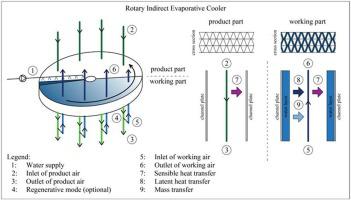Energy Conversion and Management ( IF 9.9 ) Pub Date : 2021-07-22 , DOI: 10.1016/j.enconman.2021.114514 Demis Pandelidis 1 , Aleksandra Cichoń 1 , Anna Pacak 1 , Paweł Drąg 2 , Marlena Drąg 2 , Korneliusz Sierpowski 1 , William Worek 3 , Sabri Cetin 4

|
This paper presents the concept of a Rotary Indirect Evaporative Cooler (RIEC) which the operation principle is based on implementation of evaporative cooling in rotary exchanger to increase its cooling effectiveness. The RIEC unit can operate in two modes: standard and regenerative. The mathematical model of RIEC, based on the ε–NTU method, is presented. The operation of RIEC is compared to the traditional Counter-flow Indirect Evaporative Cooler (CIEC) which also operates in two modes: standard and regenerative. Different performance indicators are introduced i.e. Energy Efficiency Ratio (EER), indicators relating the cooling capacity to cooler's length, cooler's inlet cross-section, and to cooler's overall volume. Additional two indicators are introduced to describe RIEC and CIEC operation principles by relating the cooling capacity to the rate of heat or mass transfer occurring in the wetted part of the cooler. The performance of RIEC and CIEC is compared under different climate conditions following Köppen-Geiger climate classification system. It was found that the values of performance indicators calculated for RIEC are higher than for CIEC under various operational parameters and climatic conditions. It was stated that choosing RIEC instead of CIEC allows increasing EER on average by 63% in standard mode and 88% in regenerative mode. It was concluded that RIEC is a competitive solution for cooling purposes due to its lower electricity demand and smaller dimensions.
中文翻译:

回转式间接蒸发空冷器性能分析
本文介绍了旋转间接蒸发冷却器 (RIEC) 的概念,其工作原理基于在旋转交换器中实施蒸发冷却以提高其冷却效率。RIEC 单元可以在两种模式下运行:标准模式和再生模式。提出了基于 ε-NTU 方法的 RIEC 数学模型。将 RIEC 的运行与传统的逆流间接蒸发冷却器 (CIEC) 进行比较,后者也以两种模式运行:标准模式和再生模式。引入了不同的性能指标,即能效比 (EER),这些指标将冷却能力与冷却器的长度、冷却器的入口横截面和冷却器的总体积相关联。通过将冷却能力与冷却器湿润部分中发生的传热或传质速率相关联,引入了另外两个指标来描述 RIEC 和 CIEC 操作原理。根据柯本-盖格气候分类系统,在不同气候条件下比较了 RIEC 和 CIEC 的性能。发现在各种运行参数和气候条件下,RIEC 计算的性能指标值高于 CIEC。据称,选择 RIEC 而非 CIEC 可使标准模式下的 EER 平均提高 63%,再生模式下平均提高 88%。得出的结论是,由于其较低的电力需求和较小的尺寸,RIEC 是用于冷却目的的有竞争力的解决方案。根据柯本-盖格气候分类系统,在不同气候条件下比较了 RIEC 和 CIEC 的性能。发现在各种运行参数和气候条件下,RIEC 计算的性能指标值高于 CIEC。据称,选择 RIEC 而非 CIEC 可使标准模式下的 EER 平均提高 63%,再生模式下平均提高 88%。得出的结论是,由于其较低的电力需求和较小的尺寸,RIEC 是具有竞争力的冷却解决方案。根据柯本-盖格气候分类系统,在不同气候条件下比较了 RIEC 和 CIEC 的性能。发现在各种运行参数和气候条件下,RIEC 计算的性能指标值高于 CIEC。据称,选择 RIEC 而非 CIEC 可使标准模式下的 EER 平均提高 63%,再生模式下平均提高 88%。得出的结论是,由于其较低的电力需求和较小的尺寸,RIEC 是用于冷却目的的有竞争力的解决方案。据称,选择 RIEC 而非 CIEC 可使标准模式下的 EER 平均提高 63%,再生模式下平均提高 88%。得出的结论是,由于其较低的电力需求和较小的尺寸,RIEC 是用于冷却目的的有竞争力的解决方案。据称,选择 RIEC 而非 CIEC 可使标准模式下的 EER 平均提高 63%,再生模式下平均提高 88%。得出的结论是,由于其较低的电力需求和较小的尺寸,RIEC 是用于冷却目的的有竞争力的解决方案。











































 京公网安备 11010802027423号
京公网安备 11010802027423号